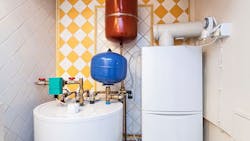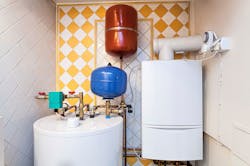I am still fighting mental health when it comes to hydronic heating. “Unbalanced” comes to mind. I have long ago left the superhighway of greater knowledge to live in the serenity of the small cul-de-sac called hydronic heating. That is where I live. If I had a pool, I would invite forced-air people to swim in my pool, but they couldn’t live in my cul-de-sac. Now that you have an idea of how fragmented my thinking has become, let me tell you about SHREK.
A friend of mine named Josh Mitchell was invited to play the lead role in a local community play called “Shrek, the Musical.” Stay with me here: It will be worthwhile in the end (I promise). Now, it would be safe for me to make the broad statement that I am not a regular patron of the theatre. As to musicals, let me just say that if you counted all of the musicals I have ever been to in my life, this would be the first. But my wife Kathy and I went.
The lights dimmed, the play began and it was actually very entertaining and very well done, but that’s not the point. Somewhere in the middle of the second act, my wife turned to me and said in a whispered excitement, “Here comes the soliloquy!”
I immediately leaned forward in anticipation. I had no idea what a soliloquy was, but she said it with such conviction that I thought it must be important. And that’s when it happened, right in the middle of the soliloquy. A revelation! It was as if a switch to all knowledge had been turned on. I was astonished that no one else could see the light bulb above my head. The Hallelujah chorus began to play. It was all there right before me. SHREK was the answer to hydronic heating!
It was so clear, so plain. SHREK was put on earth to be an acronym for all things important to hydronic heating. I immediately turned to Kathy and said, “Quick, give me a notepad and pen!” Without blinking her eyes or turning her head, she reached into her purse and handed me the notepad and pen. To even the most casual observer, this was obviously not the first time that I had asked her for a notepad and pen. I began to write furiously. Here’s what S.H.R.E.K. stands for:
S – Safety
H – Health
R – Reliability
E – Efficiency
K – Komfort
And, they are in descending order of importance. Is there anything more clear than this for hydronic heating? Each of these five categories could easily fill an article, but let me unpack this “SHREK” just a little. For now, we’ll look at the 50,000-foot view.
Safety
We’ll start with safety. (Which makes sense: We should always start with safety, right?) The main concept of safety is to try to keep the boiler in the boiler room. When we can’t do that for one reason or another, we don’t like to call them “boiler explosions,” because that implies that you might have done something wrong. Instead, we prefer to call them “unscheduled equipment relocations.” Like when your boiler relocates itself to the neighboring state.
To prevent this, our relief valves and low water cutoffs must be in good working order and tested. The debate about whether or not to test residential relief valves annually has been ongoing all my heating life, and the arguments on both sides of the issue have real merit.
Still, if safety is really first on the list, this is a no-brainer — at least for me. A pressure and temperature relief valve costs about $15 to $20 — about the cost of dinner at a local bar and grill. And it gives me a chance to blow down the crude at the bottom of the water heater.
One other very important safety concern is carbon monoxide, a very deadly and life-threatening gas. Carbon monoxide monitors are often required in new construction, but don’t wait to buy yourself a new house before you install one of these in your own home or in your customer’s home. Carbon monoxide poisoning is a low-probability, high-consequence event. Because of that, it is definitely worth the investment.
Health
Over the past few years, I have seen dozens of articles on “sick” buildings — sick with radon, formaldehydes, mold, mice droppings and poor infiltration, to name just a few. The need for knowledge about indoor air quality (IAQ) has become a very necessary part of our understanding if we truly are to be holistic heating contractors.
If you are a heating contractor and you don’t have an ASHRAE Standard 55, which addresses the thermal environmental conditions for human occupancy, this is a great starting place.
A good next step might be to visit www.healthyheating.com. Robert Bean, R.E.T., P.L.(Eng.), has done a terrific job of putting together a website of easy-to-understand and easy-to-find articles and discussions about this very issue. Robert is a very passionate activist for IAQ, and you will find the information on his website to be invaluable.
Plus, when you start discussing the IAQ topic with your customers, you will find a very sympathetic audience that will increase their confidence level in your skills. A healthy environment is a very important topic to the knowledgeable and savvy homeowners of today’s market.
Reliability
All heating equipment, no matter what brand, has a built-in computer chip that triggers it to fail on Christmas Eve at 11:30 p.m. This is common knowledge. Or, the valve will fail in the open position the first day of your two-week vacation. And it will always fail where it can do the most damage.
Going to war against the reliability gremlins is the job of preventive maintenance. This is your best hope of winning the war. Predictive maintenance, preventive maintenance and corrective maintenance are fairly well-known quantities in our industry. If you’re not up to speed on these three areas of reliability, these would also be good starting places and very good sources of revenue, I might add.
But a new player has been drafted into the reliability team: value-driven maintenance. This is based on the following four pillars.
1. Asset utilization
2. SHE (Safety, Health and Environment)
3. Cost control
4. Resource allocation
Information is coming forward that shows this new rising star could alter our current maintenance profiles and make preventive maintenance a value-driven proposal more than a reactive-defense proposal.
The problem with preventive maintenance today is customers often don’t see the value and think the contractor is just out to fleece them. Value-driven maintenance can include the homeowner in the maintenance loop, which produces ownership and much less pushback.
It’s a strategy worth investigating. At the end of the day, reliable equipment is, by definition, safer equipment. Safety and reliability swim in the same pool.
Efficiency
When I ask heating contractors what size boiler is required for a 2,500-sq.ft. home, a response of 80,000 to 100,000 BTUs is very common. This might be true if you are heating the domestic hot water, running a hot tub, snow melting the street and heating the neighbor’s house.
I’m exaggerating a little, but the proof is in the firing-time cycle. All of us have been in a homeowner’s mechanical room in the dead of winter: The boiler fires for five minutes and shuts down. Three minutes later, it fires again for three minutes and shuts down. On-off; on-off; on-off; each time costing efficiency of operation and reduction in the lifespan of the equipment.
And, of course, if the boiler is oversized, the pump is surely oversized as well. Over the life of the systems, the extra wattage used could cost more than $1,000 in additional electricity.
Unfortunately, oversized boilers and pumps are the norm, not the abnormal. And every time we add another heating zone to a hydronic system, we exacerbate the situation by creating micro-loads that thwart even the most efficient condensing boilers with 10:1 turndown ratios.
Even with modulating flames, it still short-cycles. I understand over-designing a system with a 10% safety margin. That’s not the same as “bigger is better.”
Komfort
If you’re hooked on phonics, this is the correct spelling for comfort. Similar to the spelling of kat or kow. Plus, if I had put “comfort” in there, it wouldn’t have spelled shrek, it would have spelled Shrec, and no one would bother to read the article.
Moving on, being a “komfort” installer is one very good way to differentiate yourself from all the other heating installers. As Robert Bean says, “Instead of satisfying just the thermostat, you’re just as concerned about satisfying the homeowner.”
Things like temperature drift, stratification, drafts, fan noises, odor control, allergen spread, operative temperature, thermal comfort zoning and warm bathroom floors allow you to offer different types of heating systems to meet different needs. This makes you a different type of contractor with a whole different message. Price and price differences become less of an issue, and you will find you’re not competing with other contractors on the same level.
I would love to meet the granite salesman who somehow convinced an entire nation that you couldn’t build a home without granite countertops. Warm toes on a marble bathroom floor have to be at least as enticing as a granite countertop. And if you’re looking for sheer komfort, is there anything more komfortable than a shower stall with radiant heating in the floors and in the wall? It’s like taking a shower in a cocoon!
SHREK, like any other name, is not the same if you leave any of the letters out. All of the letters have to be involved to have the name. And so it is with this situation.
If the system is komfortable, but not healthy, it’s not a SHREK home. If it’s comfortable, but making the homeowners sick, it isn’t a SHREK home, either. If everything is safe, but not reliable…you get the point.
So there you have it — SHREK heating. I would greatly enjoy hearing your feedback or, more importantly, your insights about how these disciplines interact with one another. In addition, I would also like to hear how you approach customers with similar information. Please feel free to contact me at [email protected].
Until then, have yourself a Shrek heating season!
Steve Swanson is the customer trainer at Uponor Academy in Apple Valley, Minn. He can be reached at [email protected].

